In 1851 V. Scheppers and his friar Congregation opened a boarding school at the Melaan in Mechelen (Belgium). Later it became famous with his Scheppers Institute that was named then as Pensionnat Saint-Vincent de Paul.
Pensionnat Saint-Vincent de Paul
Till 1844 the Brothers of Our-Holy-Mary of Mercy remained at their first home in the Begijnenstreet. That year the Brothers move to the renovated convent at the Melaan. In 1845 V. Scheppers founded the free day school there.

After the day school had been transferred to the Olivetenhof in 1849, space was created at the Melaan for a new initiative: V. Scheppers wanted to build an orphanage. He also wanted to take in boys from the custody house St.-Hubert who were dismissed. The orphanage was never built because the municipality had founded one herself.
In the course of the year 1851-1852 they chose for a boarding school at the Melaan, for which a prospectus was drafted and spread. That building became the well known Scheppers Institute that was named the Pensionnat Saint-Vincent de Paul. In 1871, it counted 300 boarders. Letters from old pupils from that time, testify of their great appreciation for their Honoured Father as they called their founder themselves.
Fast extension
The constant growth of the number of boarders caused a lot of problems for the friars when speaking of expansion problems. Brother Vincentius was the leader of the plans and the renovations.
On February the 12th 1852, the Congregation obtained part of the inaugurated convent of the Poor Klaren, that had been destroyed by the French in 1794. By buying the houses next to this building, new expansions were possible along the Melaan and in the Thaborstreet.
The following years other buildings in the Thaborstreet were also obtained. In 1855 the city Mechelen sold the houses wherein a school for Beguines was situated; afterwards it got different destinations. In 1857 the city surrendered a little river that crossed the large playground from east to west.
Despite the strong growth of the number of pupils in the first decennium, the young boarders were certainly well housed, according to the standards of that time. A new building that was raised in 1858 at the Thaborstreet, with classes on the ground floor, a dormitory Saint-Victor at the first floor and in the attic a space for the suitcases, still promoted the comfort.
The boarding school is a village

Where hundreds of pupils were staying for months, there was evidently a serious activity: cultivating vegetables, cooking, washing, repairing shoes and clothes, hair cutting… A 19th century boarding school seems as if it was a village.
The Brothers kept pigs and had a cow. The maintenance of the buildings, the making of the beds, looking after the sick: there were so many tasks that were performed by the Brothers or by servants, often ex- prisoners.
Naturally, besides teaching, a lot of devoted tasks and religious exercises should be done in the boarding school: playing, singing, wandering, playing theatre….
The museum
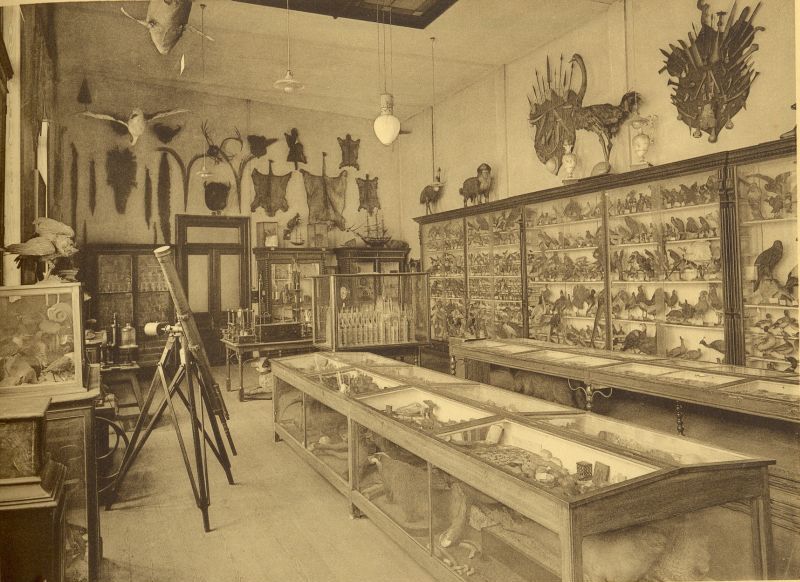
The state-horse of the institution was the museum. Brother Vincentius started with this museum of curiosities from the first day of the boarding school. On October 18th, he asked colleagues in Vilvoorde to collect coins.
Especially the Brothers who had been living abroad were suppliers of extravagant objects. At the end of the 50’s, a slipper of the Pope was one of the most wanted objects.
In the course of the following decennia, the museum was constantly extended. Also old pupils who were travelling in foreign countries or who were making business trips, helped in extending the collection of the exotic objects.
High Visitors
In lots of letters Brother Vincentius expressed pride and gratitude when he described the developments in the boarding school. Visits and praising words of eminencies were always mentioned in the letters with pride and sometimes even with a bit of humour.
A high guest who was often seen there, was Cardinal Sterckx. At least two times a year the Prince of the Church was a guest at the Melaan: once for the ceremony of the first Communion and for the Confirmation and a second time for the prize-giving. Religious eminencies were often invited at the school and especially the vicars honoured the ceremonies with their presence.
A boarding school for about 300 pupils
When Brother Vincentius died after a short disease, on September the 18th, 1871, he had left a large school. Not only had he leaded it as a headmaster, but he had also put all his knowledge and his experience in it.
His successors saw the institution growing. Within the large education offer of the Congregation, this boarding school was invariably called a boarding school for about 300 pupils of the higher class.
An own education concept and an own teaching concept
The boarding school Saint-Vincent de Paul started dubiously in 1851 as a small boarding-school without a real sharp target group nor teaching content or finality. Soon, an own education concept as well as an own teaching concept was growing out of the experience in which a religious education and life experience were the most important, besides order and discipline.
A warm and direct style characterized the pedagogical approach that was based on confidence and an almost familiar atmosphere. With a lot of practical sense, the Congregation tried to join the new needs of a rapid changing 19th century society. Not Latin and classical culture, but mathematics and modern languages would become the strong sides of that education.
After their submersion in a French education and boarding environment, the youngsters were also able to hold one’s own in the French administrative and economical life that was dominating the Flanders.
Old pupils and the school : a strong team
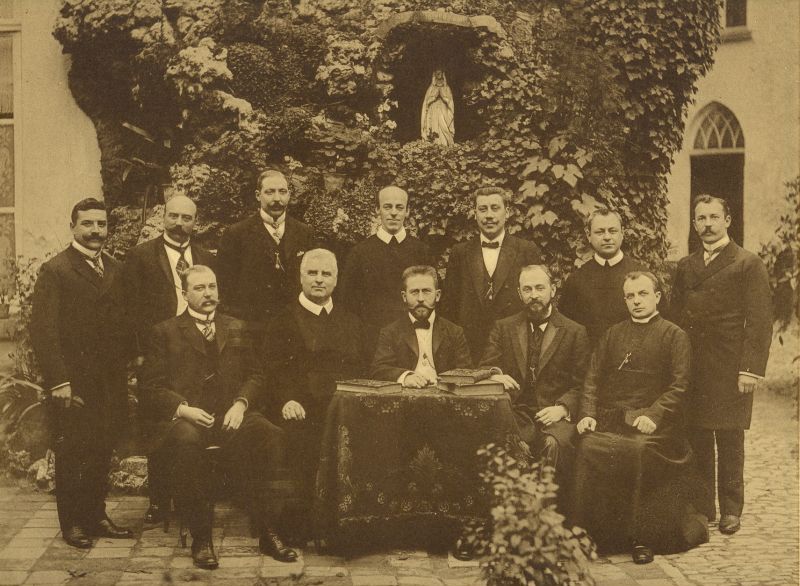
After Alsemberg had already known an union of old pupils under the impulse of Brother headmaster Pascal, the union of the old pupils of Mechelen could hardly stand behind.
The 26th of June 1908 the old pupils Union organized a first reunion. Almost 200 old pupils assembled in their former school for a holy mass, speeches and an extensive dinner.
The first general meeting was hold in an enthusiastic atmosphere. The proposal of the provisional committee to hold reunions every two year, was brushed aside. The old pupils wanted to see their second home each year !
At the speeches and toasts, Brother Pascal, headmaster of Alsemberg and one of the first old pupils of Scheppers spoke. He spoke in Dutch and the reason therefore was: among the Flemish people, Dutch was the language to be spoken !
Promptly, he met approval of Emily Van Reeth who was rather Flemish-minded and who was also a brick-maker boss. He expressed his emotions when hearing the Dutch language although the report of the first meeting was completely set in French. That was changing the following years. The Dutch speeches were also taken up in Dutch.
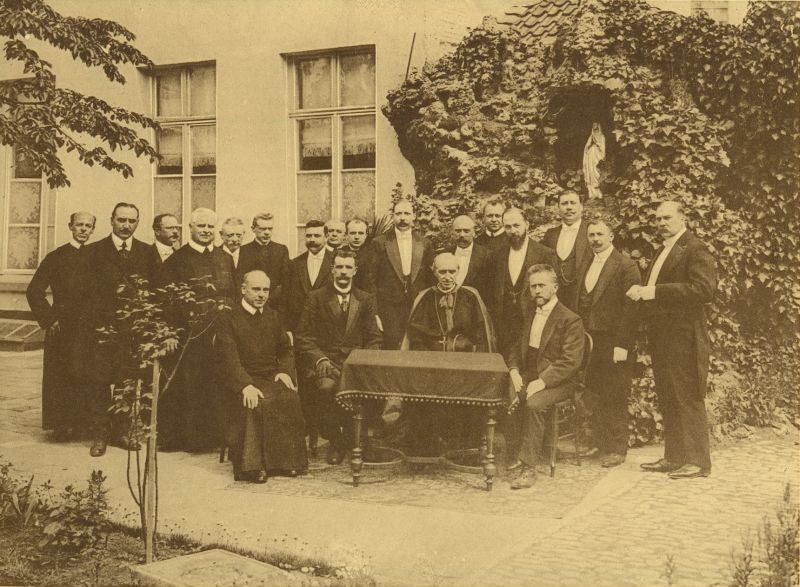
So the tone was set as to the Union of the old pupils at least till the first World War. Its reunions were a feast with about 250 à 350 persons who honoured their founder Scheppers, the Brothers and their deserving old-pupils.
Besides the reunions, theatre and singing evenings were arranged, scholarships were awarded and deserving pupils were honoured. In the speeches there was always a militant Catholicism. Already during the first reunion, Emile Van Reeth was clear in this: The Catholic Cause needs us !
In 1912, the five years of existence of the Union of old pupils got an extra splendor by the presence of Cardinal Mercier and the Minister Prosper Pullet. This last one gave a polemical speech by defending the Catholic education.
Private School
In the period until the first World War, the friars were number one as to education and boarding school life. The boarding school was completely situated in the private atmosphere which meant that the Brothers could offer services without a governmental control or recognition and the parents therefore paid board and school fee.
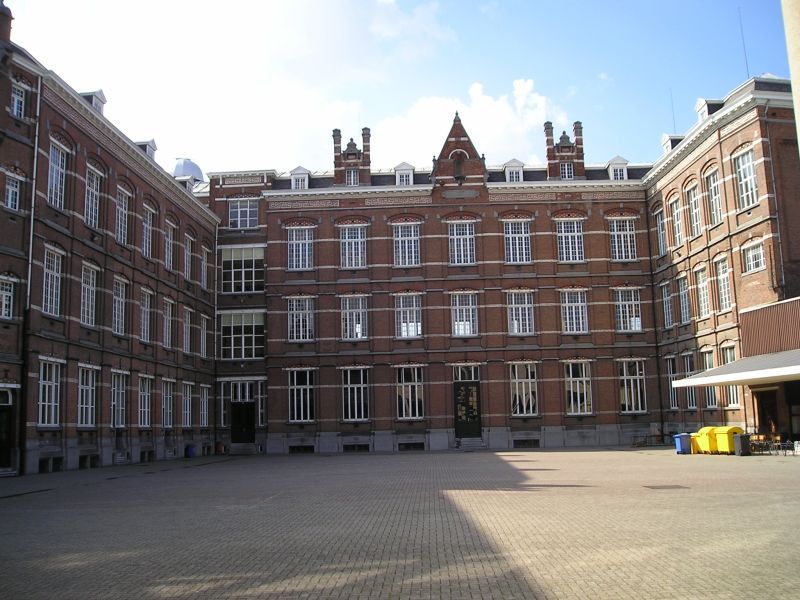
The Brothers built their schools out of the needs they saw in the society and successfully they followed the wishes of the parents. According to the time spirit, education was penetrated with a Christian life vision. In the contacts with their pupils, they created an atmosphere of simplicity, cheerfulness and comradeship.
Means in their education were surveillance and discipline at every moment and in every place, a permanent evaluation of and a rivalry amongst the pupils, a public proclamation of the study results, a healthy variety between study and “animated recreations”, in which the Brothers played and sported with them and they also took part in lots of cultural activities like music, theatre and reading.
Permanent availability
From the Brothers, a permanent availability was demanded for that educational system. Their unselfish and indefatigable devotion was praised more than once.
Most of the Brothers got their knowledge and their skills from practice. Experience, self study, learning from an older friar, lessons in the “iuvenat” and the “novitiate” were also ways to master the challenges of education and teaching.
A model institution
Looking back on his life and his carrier, Brother Theodoor wrote with a lot of respect about Scheppers. This great defender of the necessity of an own school for young teachers, that would be built in Alsemberg after the first World War, made that the lack of a training was felt in lots of institutions of the Congregation, … but not in Scheppers.
In the image building of the Congregation , Scheppers was a model institution, that came up to a lot of demands and expectations of the parents and the pupils with capable teachers and almost every year more candidates than the boarding school could lodge.
A school headmaster and a Brother Superior in a convent
From the very First formation of the Saint-Vincentius boarding school till in the recent past, it was a rule that the headmastership of a school was done by the Superior of the House in Mechelen that was moreover the Mother House. That meant that the board of a school and the headmastership of the Brother community were very much bound together.
After the long headmastership of Brother Vincentius from 1851 till his death in 1871, the headmasters succeeded each other very quickly. The reason of this was, amongst others, the many activities of the Congregation and the conclusions of the General Superior to put Brothers with a lot of experience and organization talent in other houses.
A new building for a new century
At the threshold of the 20th century, the boarding school set out for a new area. A new building had to become the actual expression of her vitality and vision. The architect Jozef Rooms (1871-1929) signed for the plans.
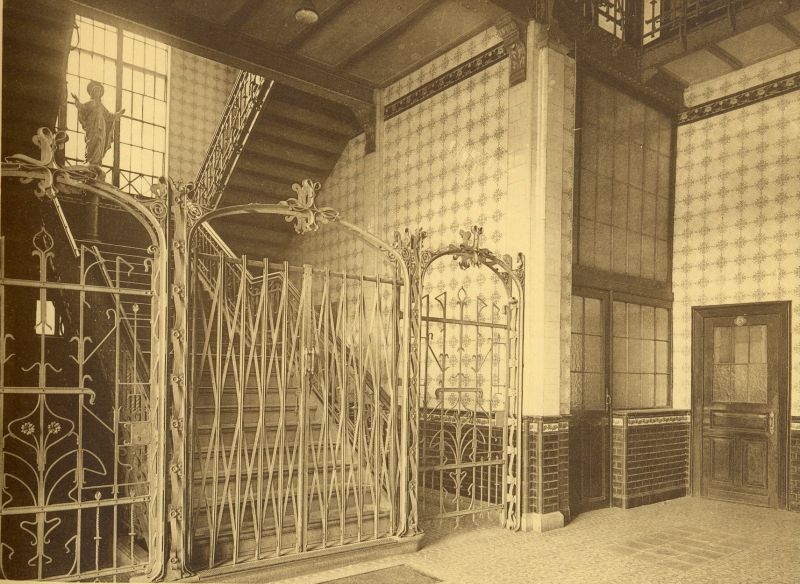
1st May 1901 the board of aldermen in Mechelen admitted the brook, that run straight through the terrains, to be bridged over. A few older constructions were demolished so that a streamlined building in red and white bricks with a large stair hall, a festivity hall with a gallery, large rooms for a museum, a drawing room, a physics room, and a lot of dormitory rooms, devoted to angels and saints, could be built and in the cellar a washing place and a room to clean the shoes.
The chairman of the old pupils Union F. Giele, called the buildings and especially the festivity hall that was built in 1902 one of the most beautiful constructions ever built in Belgium.
A hitch
The first years after the new building was put into use in 1902, the side wings were also renovated and adapted. With a functional construction and trees upon the playground, the boarding school got an actual outlook.
Although it seemed the building showed a hitch: the architects had forgotten the toilets in the proximity of the dormitories! Therefore they were built, as a column, just aside the building. Later, they had been removed.
The new building was also hidden behind a 19th century convent wall that also waited for renovation. In 1906 the Superior decided that the Scheppers Institute, after being rebuilt and after being renovated, was a magnificent building, constructed with all the necessary supplies, but… that a new front wall alongside the Melaan and a new chapel were an absolute necessity.
A dream building but it never became true…
In 1913 adaptations and renovations of the front were promised; plans were made to renovate the buildings alongside the Melaan. They chose for a Neo- Gothic building that would be in harmony with the still existing chapel.
The plans were made by Edmond Feel. When in 1914 the contractor had already delivered the materials and the construction could start, the Great War decided otherwise.
After 1918, the plans were forgotten, although the contractor could only get half of its materials back. The postcards with the dream building upon it,(that never became reality), are still a witness of the past that never became true.
A school in wartime
The school year 1914-1915 was mostly characterized by the war. Because of the bombing on Mechelen, 8th October, the boarding school had to close; at the end of October, life at the Melaan would retake.
During the German occupation, education could be given, but in a restricted way. Because of the fact that the Saint-Rombouts Cathedral couldn’t be used temporarily for religious services, the chapel of the boarding school was used as the parish church.
A war memorial
In 1920, at the inauguration of the memorial plaque for perished old pupils, a cantata of homage was given. Afterwards, it was repeated different times for example in 1927 at the 75 year jubilee of the school and also in 1952, at the 100 years of existence and also when the relics of Mgr. Scheppers were brought to Mechelen as well as with the inauguration of the mortuary chapel.
One of the songs became The song of Scheppers, the favourite song of pupils and especially of old pupils. The song expresses gratitude and nostalgia for the place where the air was filled with summer songs”, where the young spirits were fed and drilled and where there was always an open heart for shelter that could be used as a shield when there were small or greater grieves…Or how the memory of a youth period gets a glance and could even cope with negative experiences or where they could be rationalized !
A Dutch influence
After the first World War the Institute would not only stay French speaking but it would adapt to the new times. One of the first challenges that the Institute was faced to, was the Dutch influence. Connected with this fact, new perspectives also developed.
In the first half of the 20th century, the school would grow out from a French speaking private boarding school to a Dutch speaking modern Humanity School, free from all governmental control, but a school that delivered homologized diploma’s that opened the gates to higher education.
In the fifties, the six years of the preparatory division got the name of what they had been for a long time : an elementary school.
School Life in World War II
At the end of 1939 the war circumstances could already be felt in school life. A few Brothers were mobilized so that the organization of the boarding school life became difficult. When Germany attacked Belgium on May 10th 1940, the Pentecost holidays (12 May) were brought forward with one day.
Everybody left the Institute. A few Brothers and its priest fled to France. The headmaster Basiel and a few Brothers stayed in Mechelen. 19th May at 23.00u the German soldiers entered the Institute. They appropriated one of the dormitories and also wished to use the bathing room of the pupils. According to the headmaster they behaved properly and he absolutely had no complaints.
4th June lessons were retaken with about 50 external pupils and 24th June, 145 boarding pupils followed. The school year was prolonged till the end of July. 2nd September the new school year would start. Meanwhile the Brothers returned from their escape and the lessons were retaken.
30th September, the Germans cleared the rooms. The Institute preserved its normal rhythm for a long time, but at the end of 1943 and in the first half of 1944 it was greatly disturbed. In the beginning of December 1943, the headmaster had to clear the institute so as to give shelter for a couple of days to 500 withdrawing German soldiers.
After the pupils had been sent home, and the rooms were set in order following the instructions of the Germans, and when the Brothers had worked during 24 hours under the leadership of the vice principal Omer, they got the message that the rooms wouldn’t be used. In the beginning of the month of January, lessons could retake with about 400 pupils.
In April there was again some war violence. 19th April ,22nd April and 1st May, Mechelen was bombed. There was a lot of damage; after the third bombardment, the headmaster wrote: as if it had been a miracle, that the school was spared from destruction.
10th May, the Germans occupied the rooms. The lessons were taught in Saint-Johns school. Every day 100 to 200 civilians sought for a place to hide in the school. In the beginning of May, even a child was born in the converted washing place.
4th September Mechelen was freed and at the end of that month a new school year could start. The headmaster confirmed not having too much trouble of the English soldiers who used part of the building.
Exit of the boarding school
In September 1967, 80 small rooms were used by the boys of the highest classes. Then they were proud about their boarding-school. 300 of the 1000 pupils were then boarding students. Since then, year after year the number of boarding pupils diminished.
In 1988 it was decided to cut down the boarding school completely. The bedrooms could be used as teaching rooms. A 100 year tradition was gone. On the fourth floor along the Melaan a row of small radiators still recall the luxury of individual heating, installed in 1960 to adapt the boarding life at the demands of that period.
Metamorphosis
From maximum 400 pupils the school developed into about 400 pupils in the primary division and in the infant classes and about 800 pupils in the secondary division. From a boarding school with a few external pupils, the school now became full day-scholar. The boys school became mixed and the teaching staff as well as its complete population started to feminize.
Since the beginning of the 20th century a lot of things had been renovated and adapted in the surroundings of the Melaan, but there was no money for a new building. The school was a complex of classes and rooms that were furnished provisionally because there was an acute lack of space, stayed there as a temporary solution.
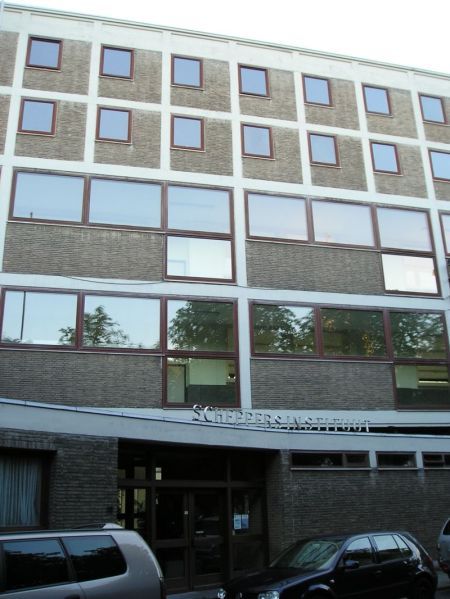
The need for classrooms was partially solved when the Institute took over the former classrooms of the “O-.L-.Vrouw school”. The decreasing number of boarding pupils made it thus possible that dormitories were reconverted into classrooms. But the school had always an permanent lack of space.
Besides the 19th century convent front waited for demolition already since 1914 and was waiting for a new building. About 1960 a few new acquisitions could be done. These made it possible that the school could be extended a bit along the” Molenstreet” (the recent Thaborstreet). 6 class rooms were built there.
New plans for extension and for new buildings along the Melaan could also be realized. This time, no preferences for Neo-Gothic or other architectural wishes; only functionality, soberness and reinforced concrete.
The ambitious building project resulted in 13 teaching rooms, two laboratories, a gym room, a cultural centre, an auditory, office rooms, a reception hall, study rooms and bedrooms. In the new building a lot of attention was given to festivities and reunions with old pupils.
A constant construction
The growing number of the pupils soon caused new space problems and also created new needs : a documentation centre, hobby rooms and especially a large sports hall. The friars were always on the look-out for a house or a storehouse that was free and that they could eventually buy.
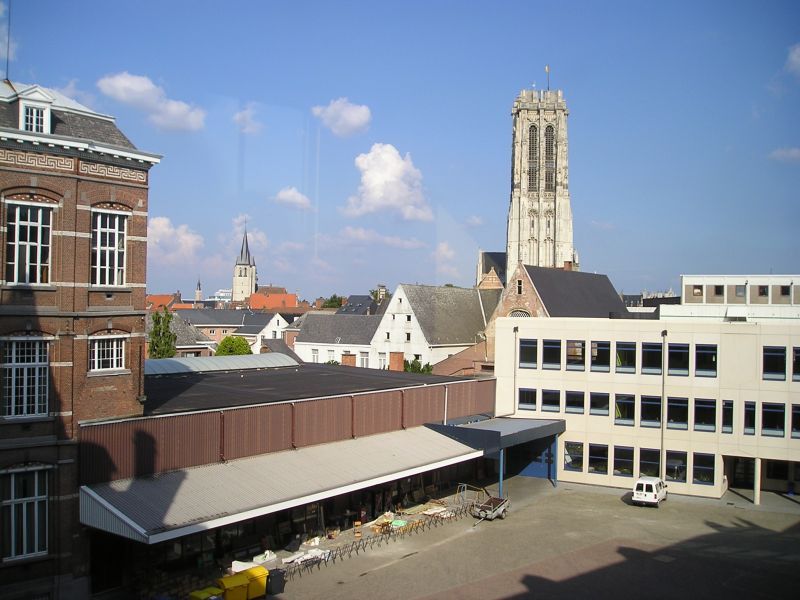
A lack of teaching rooms, play rooms and living rooms for the youth has always been the main search in the history of the Scheppers Institute. The search for class rooms, dormitories, living rooms and playgrounds was a permanent trouble for each headmaster, from Friar VIncentius in 1851 till headmaster Vercauteren in 2001.
Even during the schoolyears 2000-2001 and 2001-2002, the Institute was partly a construction place. The old building, that was constructed right over the playground in the 19th century, was demolished. The kitchen walls went down and the windows disappeared, but school life went on normally.
For a while the playground was bigger than ever and the facade of the 100 year old building was now visible in its complete breadth. Now, a new building again hinders the sight of the open space on the play ground. New classes are waiting for new generations of pupils.
The Observatory
Not only Frank Deboosere, but lots of school fellows could show their interest for meteorology and for the astronomy during their humanities and this thanks to the observatory, The observatory was built by the Brothers Robert and Timothée above the staircase in the building dating from 1902. Therefore the walls from the balcony on the highest floor were raised and provided with a dome-shaped roof. Brother Robert who was a math and chemistry teacher, drafted the concept. Brother Timothée on the other hand, worked a lot of hours in the dome and in the making of the equipment.
The interest for the astronomy had already been cultivated in the school since the years 1930. When the Germans used the little balcony as an observation post, at the end of the war, the idea of a permanent observatory started to grow. Teachers and interested pupils formed associations where they could exercise their hobby.
In the 70years the club Pallas was active with Frank Deboosere as chairman and its most important person. In the 80s Orion was founded. The association still meets regularly in the observatory.
A school life full of energy
In the Scheppers Institute there has always been lots of space for sports days, hobby exhibitions, diction contests, a cross, a grandparents feast, a cultural week, a few days of holiday trips etc… Besides the programs and the lessons, there was so much more.
One of the ideas of a few supporters can find interest soon: a play, a quiz, a musical or an eating feast to bring parents and sympathizers closer to the school. But also for technical adaptations, like the installation of the nature-historical museum, or a laboratory for chemistry or physics, was made by pupils and teachers together.
On the Web

In the 80s they worked hard to introduce the computer in the education and in the office cooperation. In 1997 Scheppers-Mechelen got a place on the World Wide Web. Nor for teachers of the primary school as well as for the secondary division, nor for the pupils, computer fear is absolutely out of the question. During the lunch pause, they often worked in the computer class.
It seems that building together to a specific school culture where young people like to learn, where they like to live together and enjoy feasts, is a permanent element in the Scheppers tradition. For those who take a look in the school calendar of the latest years, can only approve that.
150 years young
IIn 2002 the Scheppers Institute Mechelen, celebrated its 150 years of Jubilee with amongst others the edition of SCHEPPERS, OUR SCHOOL by An Hermans. Out of this source is taken o lot of what we’ve written here.
In 2018 the Scheppers Institute counts 144 staff members and 1311 pupils of which there are 197 todlers, 324 pupils in the primary school and 790 in the secondary division.
Source: SCHEPPERS, OUR SCHOOL by An Hermans, printed in 2002





